check engine Hyundai Ioniq Electric 2019 Owner's Manual - RHD (UK, Australia)
[x] Cancel search | Manufacturer: HYUNDAI, Model Year: 2019, Model line: Ioniq Electric, Model: Hyundai Ioniq Electric 2019Pages: 526, PDF Size: 16.63 MB
Page 2 of 526
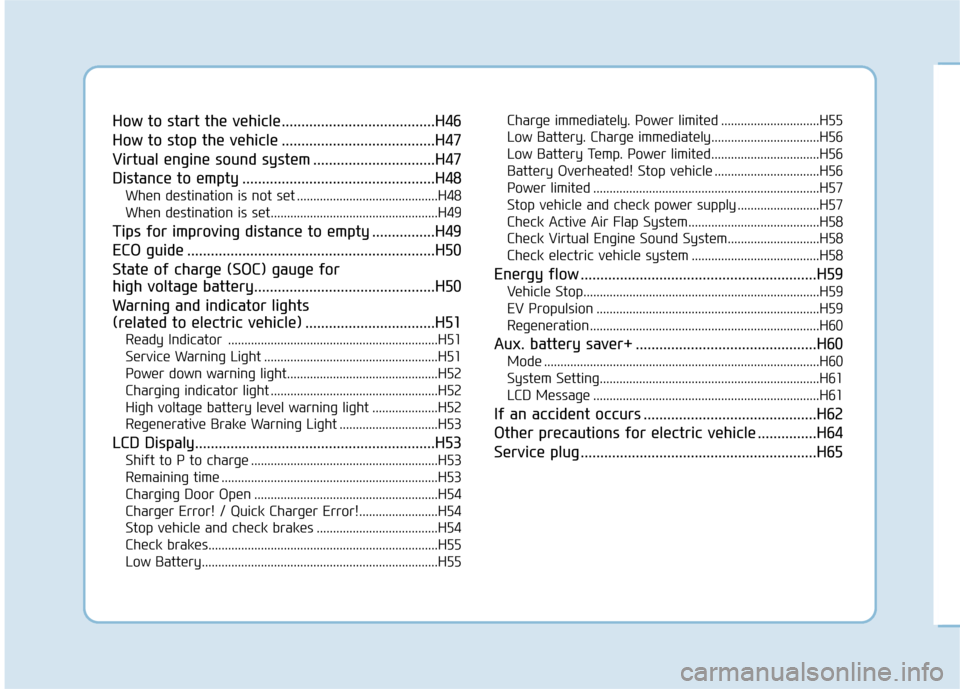
How to start the vehicle.......................................H46
How to stop the vehicle .......................................H47
Virtual engine sound system ...............................H47
Distance to empty .................................................H48
When destination is not set ...........................................H48
When destination is set...................................................H49
Tips for improving distance to empty ................H49
ECO guide ...............................................................H50
State of charge (SOC) gauge for
high voltage battery..............................................H50
Warning and indicator lights
(related to electric vehicle) .................................H51
Ready Indicator ................................................................H51
Service Warning Light .....................................................H51
Power down warning light..............................................H52
Charging indicator light ...................................................H52
High voltage battery level warning light ....................H52
Regenerative Brake Warning Light ..............................H53
LCD Dispaly.............................................................H53
Shift to P to charge .........................................................H53
Remaining time ..................................................................H53
Charging Door Open ........................................................H54
Charger Error! / Quick Charger Error!........................H54
Stop vehicle and check brakes .....................................H54
Check brakes......................................................................H5\
5
Low Battery........................................................................\
H55Charge immediately. Power limited ..............................H55
Low Battery. Charge immediately.................................H56
Low Battery Temp. Power limited.................................H56
Battery Overheated! Stop vehicle ................................H56
Power limited .....................................................................H57\
Stop vehicle and check power supply .........................H57
Check Active Air Flap System........................................H58
Check Virtual Engine Sound System............................H58
Check electric vehicle system .......................................H58
Energy flow ............................................................H59
Vehicle Stop........................................................................\
H59
EV Propulsion ....................................................................H59
Regeneration......................................................................H6\
0
Aux. battery saver+ ..............................................H60
Mode ........................................................................\
............H60
System Setting...................................................................H61
LCD Message .....................................................................H61\
If an accident occurs ............................................H62
Other precautions for electric vehicle ...............H64
Service plug ............................................................H65
Page 47 of 526
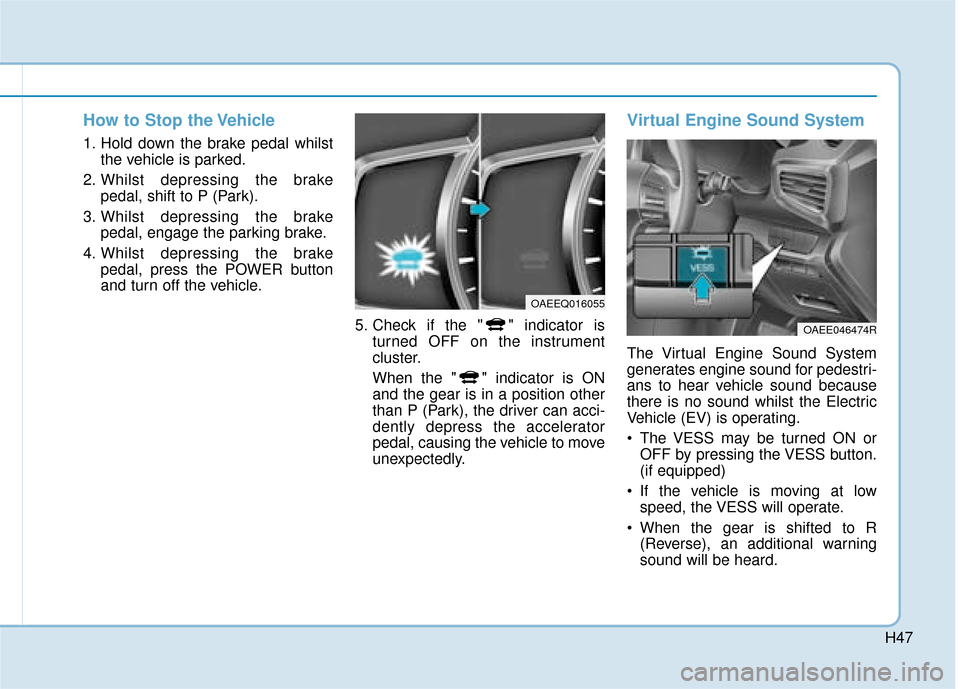
H47
How to Stop the Vehicle
1. Hold down the brake pedal whilstthe vehicle is parked.
2. Whilst depressing the brake pedal, shift to P (Park).
3. Whilst depressing the brake pedal, engage the parking brake.
4. Whilst depressing the brake pedal, press the POWER button
and turn off the vehicle.
5. Check if the " " indicator isturned OFF on the instrument
cluster.
When the " " indicator is ON
and the gear is in a position other
than P (Park), the driver can acci-
dently depress the accelerator
pedal, causing the vehicle to move
unexpectedly.
Virtual Engine Sound System
The Virtual Engine Sound System
generates engine sound for pedestri-
ans to hear vehicle sound because
there is no sound whilst the Electric
Vehicle (EV) is operating.
The VESS may be turned ON orOFF by pressing the VESS button.
(if equipped)
If the vehicle is moving at low speed, the VESS will operate.
When the gear is shifted to R (Reverse), an additional warning
sound will be heard.
OAEEQ016055
OAEE046474R
Page 58 of 526
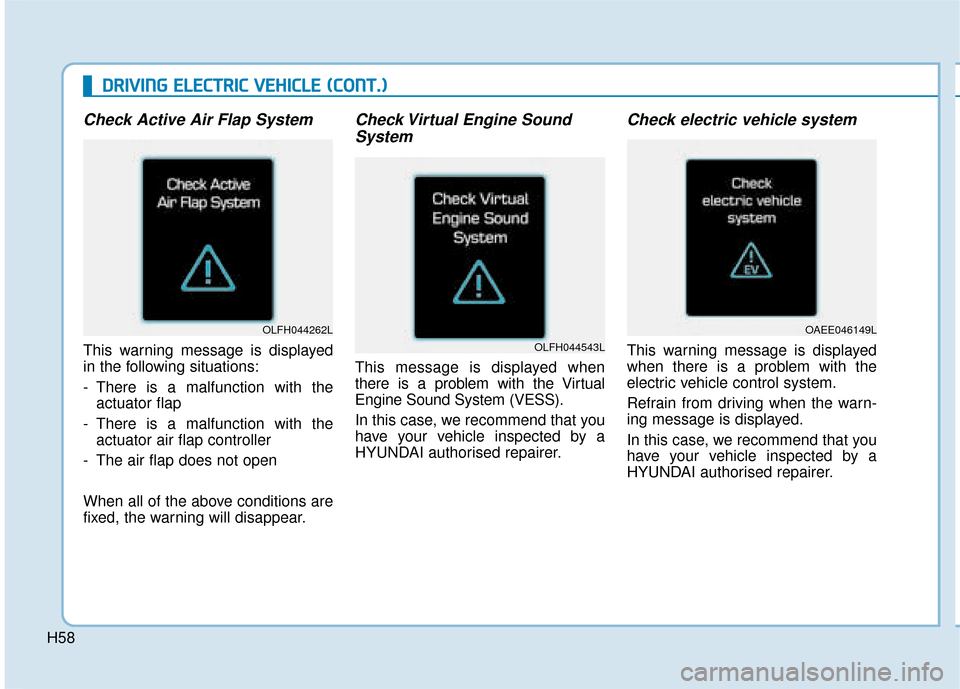
D
DR
RI
IV
V I
IN
N G
G
E
E L
LE
E C
CT
T R
R I
IC
C
V
V E
EH
H I
IC
C L
LE
E
(
( C
C O
O N
NT
T.
.)
)
Check Active Air Flap System
This warning message is displayed
in the following situations:
- There is a malfunction with the
actuator flap
- There is a malfunction with the actuator air flap controller
- The air flap does not open
When all of the above conditions are
fixed, the warning will disappear.
Check Virtual Engine Sound System
This message is displayed when
there is a problem with the Virtual
Engine Sound System (VESS).
In this case, we recommend that you
have your vehicle inspected by a
HYUNDAI authorised repairer.
Check electric vehicle system
This warning message is displayed
when there is a problem with the
electric vehicle control system.
Refrain from driving when the warn-
ing message is displayed.
In this case, we recommend that you
have your vehicle inspected by a
HYUNDAI authorised repairer.
OAEE046149L
OLFH044543L
OLFH044262L
H58
Page 211 of 526
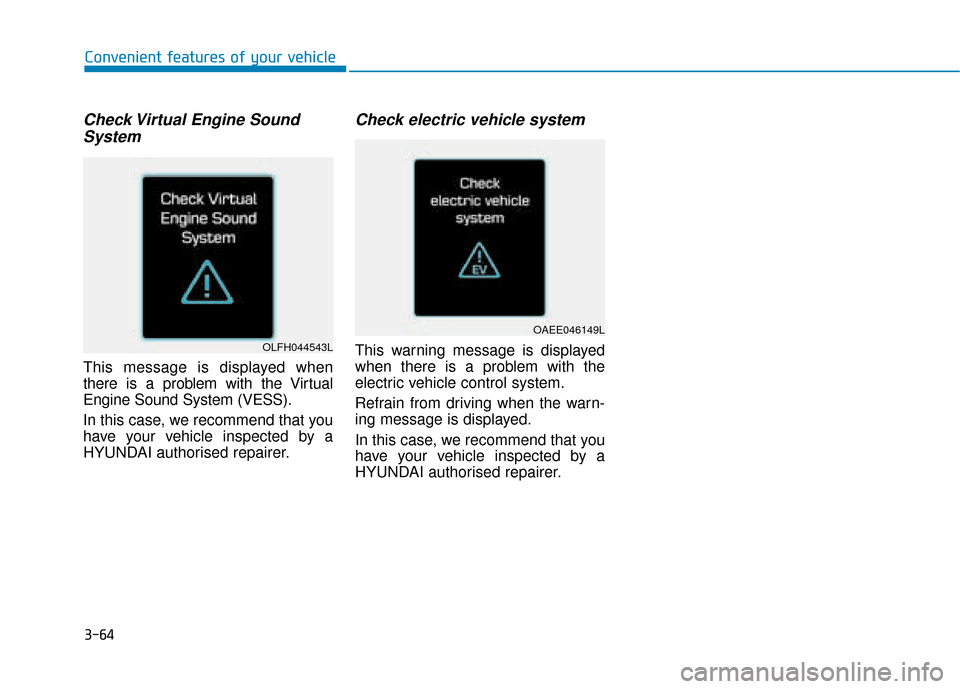
3-64
Convenient features of your vehicle
Check Virtual Engine SoundSystem
This message is displayed when
there is a problem with the Virtual
Engine Sound System (VESS).
In this case, we recommend that you
have your vehicle inspected by a
HYUNDAI authorised repairer.
Check electric vehicle system
This warning message is displayed
when there is a problem with the
electric vehicle control system.
Refrain from driving when the warn-
ing message is displayed.
In this case, we recommend that you
have your vehicle inspected by a
HYUNDAI authorised repairer.
OAEE046149L
OLFH044543L
Page 239 of 526
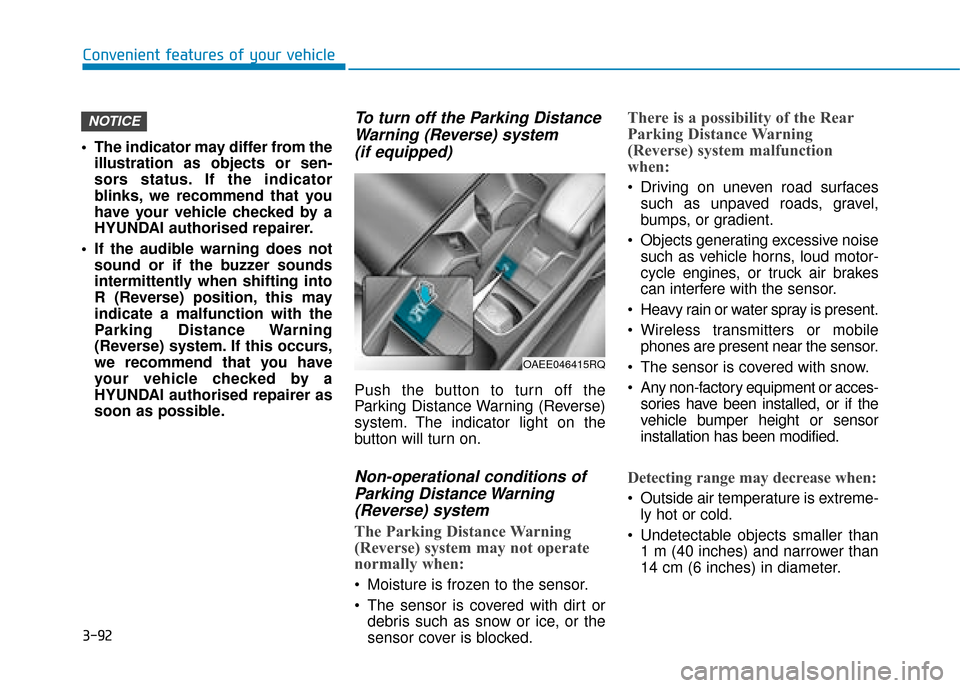
3-92
Convenient features of your vehicle
The indicator may differ from the illustration as objects or sen-
sors status. If the indicator
blinks, we recommend that you
have your vehicle checked by a
HYUNDAI authorised repairer.
If the audible warning does not sound or if the buzzer sounds
intermittently when shifting into
R (Reverse) position, this may
indicate a malfunction with the
Parking Distance Warning
(Reverse) system. If this occurs,
we recommend that you have
your vehicle checked by a
HYUNDAI authorised repairer as
soon as possible.
To turn off the Parking DistanceWarning (Reverse) system (if equipped)
Push the button to turn off the
Parking Distance Warning (Reverse)
system. The indicator light on the
button will turn on.
Non-operational conditions ofParking Distance Warning(Reverse) system
The Parking Distance Warning
(Reverse) system may not operate
normally when:
Moisture is frozen to the sensor.
The sensor is covered with dirt or
debris such as snow or ice, or the
sensor cover is blocked.
There is a possibility of the Rear
Parking Distance Warning
(Reverse) system malfunction
when:
Driving on uneven road surfacessuch as unpaved roads, gravel,
bumps, or gradient.
Objects generating excessive noise such as vehicle horns, loud motor-
cycle engines, or truck air brakes
can interfere with the sensor.
Heavy rain or water spray is present.
Wireless transmitters or mobile phones are present near the sensor.
The sensor is covered with snow.
Any non-factory equipment or acces- sories have been installed, or if the
vehicle bumper height or sensor
installation has been modified.
Detecting range may decrease when:
Outside air temperature is extreme-ly hot or cold.
Undetectable objects smaller than 1 m (40 inches) and narrower than
14 cm (6 inches) in diameter.
NOTICE
OAEE046415RQ
Page 242 of 526
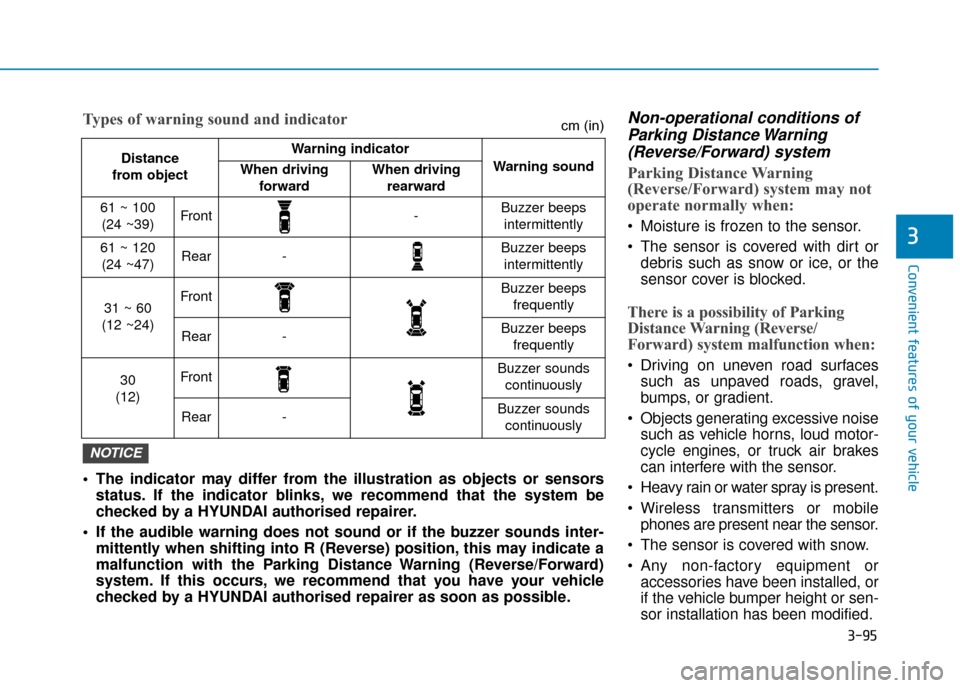
3-95
Convenient features of your vehicle
3
Non-operational conditions ofParking Distance Warning(Reverse/Forward) system
Parking Distance Warning
(Reverse/Forward) system may not
operate normally when:
Moisture is frozen to the sensor.
The sensor is covered with dirt or
debris such as snow or ice, or the
sensor cover is blocked.
There is a possibility of Parking
Distance Warning (Reverse/
Forward) system malfunction when:
Driving on uneven road surfacessuch as unpaved roads, gravel,
bumps, or gradient.
Objects generating excessive noise such as vehicle horns, loud motor-
cycle engines, or truck air brakes
can interfere with the sensor.
Heavy rain or water spray is present.
Wireless transmitters or mobile phones are present near the sensor.
The sensor is covered with snow.
Any non-factory equipment or accessories have been installed, or
if the vehicle bumper height or sen-
sor installation has been modified.
Distance
from object Warning indicator
Warning soundWhen driving forwardWhen driving rearward
61 ~ 100(24 ~39)Front-Buzzer beeps intermittently
61 ~ 120(24 ~47)Rear-Buzzer beeps intermittently
31 ~ 60
(12 ~24)FrontBuzzer beeps frequently
Rear-Buzzer beeps frequently
30
(12)FrontBuzzer sounds continuously
Rear-Buzzer sounds continuously
The indicator may differ from the illustration as objects or sensors status. If the indicator blinks, we recommend that the system be
checked by a HYUNDAI authorised repairer.
If the audible warning does not sound or if the buzzer sounds inter- mittently when shifting into R (Reverse) position, this may indicate a
malfunction with the Parking Distance Warning (Reverse/Forward)
system. If this occurs, we recommend that you have your vehicle
checked by a HYUNDAI authorised repairer as soon as possible.
NOTICE
Types of warning sound and indicatorcm (in)
Page 429 of 526
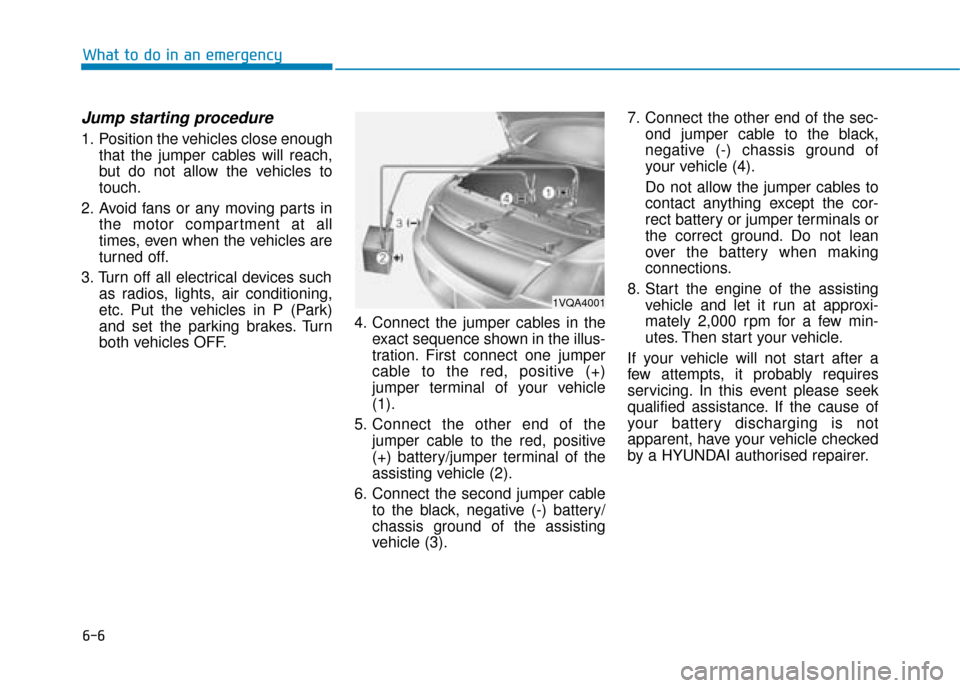
6-6
What to do in an emergency
Jump starting procedure
1. Position the vehicles close enoughthat the jumper cables will reach,
but do not allow the vehicles to
touch.
2. Avoid fans or any moving parts in the motor compartment at all
times, even when the vehicles are
turned off.
3. Turn off all electrical devices such as radios, lights, air conditioning,
etc. Put the vehicles in P (Park)
and set the parking brakes. Turn
both vehicles OFF. 4. Connect the jumper cables in the
exact sequence shown in the illus-
tration. First connect one jumper
cable to the red, positive (+)
jumper terminal of your vehicle
(1).
5. Connect the other end of the jumper cable to the red, positive
(+) battery/jumper terminal of the
assisting vehicle (2).
6. Connect the second jumper cable to the black, negative (-) battery/
chassis ground of the assisting
vehicle (3). 7. Connect the other end of the sec-
ond jumper cable to the black,
negative (-) chassis ground of
your vehicle (4).
Do not allow the jumper cables to
contact anything except the cor-
rect battery or jumper terminals or
the correct ground. Do not lean
over the battery when making
connections.
8. Start the engine of the assisting vehicle and let it run at approxi-
mately 2,000 rpm for a few min-
utes. Then start your vehicle.
If your vehicle will not start after a
few attempts, it probably requires
servicing. In this event please seek
qualified assistance. If the cause of
your battery discharging is not
apparent, have your vehicle checked
by a HYUNDAI authorised repairer.
1VQA4001
Page 461 of 526
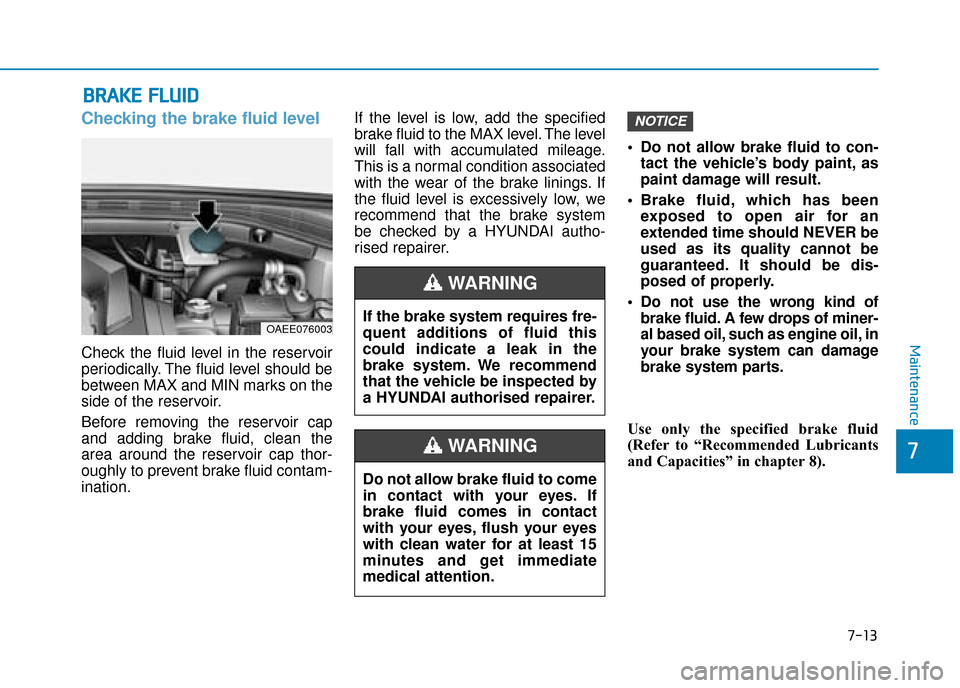
7-13
7
Maintenance
B
BR
RA
A K
KE
E
F
F L
LU
U I
ID
D
Checking the brake fluid level
Check the fluid level in the reservoir
periodically. The fluid level should be
between MAX and MIN marks on the
side of the reservoir.
Before removing the reservoir cap
and adding brake fluid, clean the
area around the reservoir cap thor-
oughly to prevent brake fluid contam-
ination. If the level is low, add the specified
brake fluid to the MAX level. The level
will fall with accumulated mileage.
This is a normal condition associated
with the wear of the brake linings. If
the fluid level is excessively low, we
recommend that the brake system
be checked by a HYUNDAI autho-
rised repairer.
Do not allow brake fluid to con-
tact the vehicle’s body paint, as
paint damage will result.
Brake fluid, which has been exposed to open air for an
extended time should NEVER be
used as its quality cannot be
guaranteed. It should be dis-
posed of properly.
Do not use the wrong kind of brake fluid. A few drops of miner-
al based oil, such as engine oil, in
your brake system can damage
brake system parts.
Use only the specified brake fluid
(Refer to “Recommended Lubricants
and Capacities” in chapter 8).
NOTICE
OAEE076003If the brake system requires fre-
quent additions of fluid this
could indicate a leak in the
brake system. We recommend
that the vehicle be inspected by
a HYUNDAI authorised repairer.
WARNING
Do not allow brake fluid to come
in contact with your eyes. If
brake fluid comes in contact
with your eyes, flush your eyes
with clean water for at least 15
minutes and get immediate
medical attention.
WARNING
Page 493 of 526
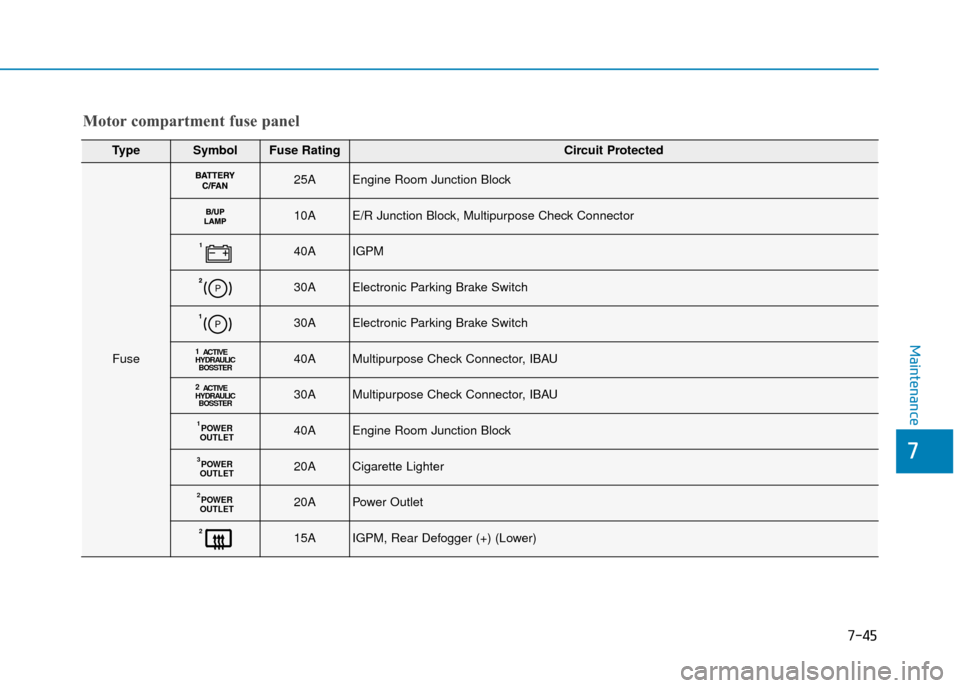
7-45
7
Maintenance
TypeSymbolFuse RatingCircuit Protected
Fuse
25AEngine Room Junction Block
10AE/R Junction Block, Multipurpose Check Connector
140AIGPM
30AElectronic Parking Brake Switch
30AElectronic Parking Brake Switch
1ACTIVE
HYDRAULIC BOSSTER40AMultipurpose Check Connector, IBAU
2 ACTIVE
HYDRAULIC BOSSTER30AMultipurpose Check Connector, IBAU
POWER
OUTLET140AEngine Room Junction Block
POWER
OUTLET320ACigarette Lighter
POWER
OUTLET220APower Outlet
215AIGPM, Rear Defogger (+) (Lower)
Motor compartment fuse panel
Page 494 of 526
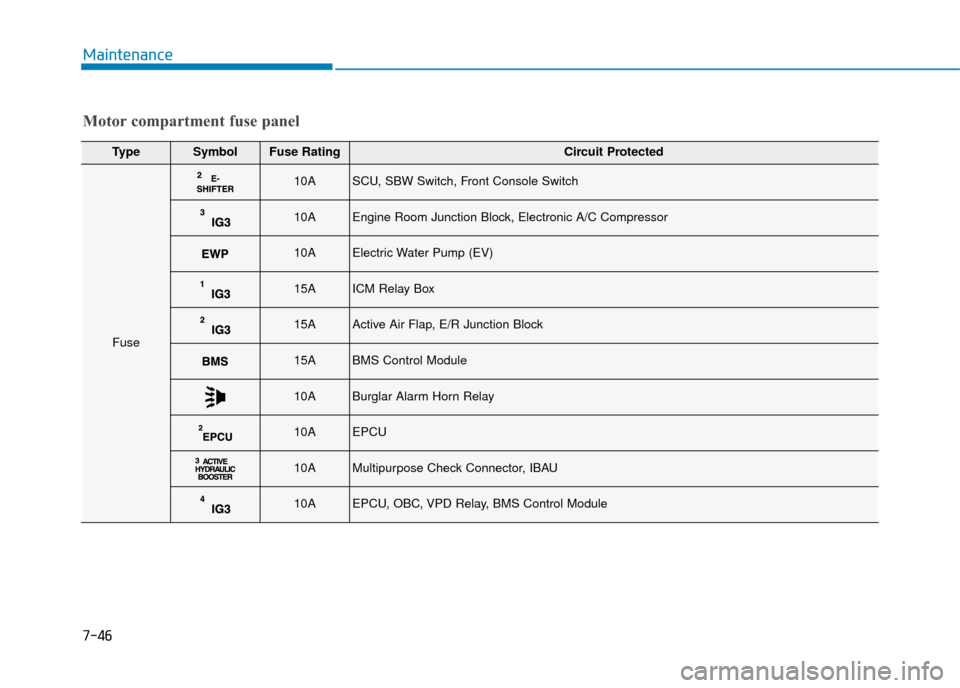
7-46
Maintenance
TypeSymbolFuse RatingCircuit Protected
Fuse
10ASCU, SBW Switch, Front Console Switch
10AEngine Room Junction Block, Electronic A/C Compressor
10AElectric Water Pump (EV)
15AICM Relay Box
15AActive Air Flap, E/R Junction Block
15ABMS Control Module
10ABurglar Alarm Horn Relay
10AEPCU
10AMultipurpose Check Connector, IBAU
10AEPCU, OBC, VPD Relay, BMS Control Module
Motor compartment fuse panel